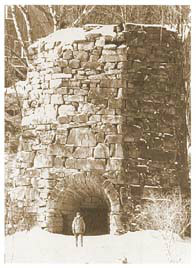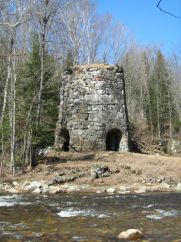Besaw Iron Furnace Interpretive Center

The Only Blast Furnace Still Standing in New Hampshire
The octagonal stone stack that is visible on the far bank of the Gale River is all that remains of a 200-year-old iron smelter shown on an 1805 map of Franconia.
The New Hampshire Iron Factory Company rebuilt the original furnace several
times, adding hot blast after 1840 and extending the height to its present 32ft.
Chiseled into one of the heavy stones in the west arch opening is "S. Pettee, Jr. 1859". Pettee was a well-known iron master who was associated with several
blast furnaces in New England. He was the last known foreman to operate this furnace.
The furnace was built of local granite. Its interior is lined with firebrick, laid in a cylindrical shape. The
space between the firebrick and stone exterior is filled with clay.
Farmers burned trees to make charcoal to fire the furnace. Iron production declined by 1865 as the ore and trees diminished and as iron production in Pennsyvania progressed at less cost. The furnace was abandoned with a belly full of once-molten iron. The furnace had been inactive for twenty years when, in 1884, the shed that surrounded it burned to the ground.
Visitors can see a scale model of the furnace and the shed that enclosed it.Also on display at the Interpretive Center are an ore cart, stove, kettles and tools, as well as panels explaining the process. The Franconia Heritage Museum offers additional displays of iron and books on the subject.
NOTE: Viewable anytime from the Picnic Area. The stone stack, itself, is on private property across the Gale River. Trespassing is prohibited due to the danger of falling stones.
The octagonal stone stack that is visible on the far bank of the Gale River is all that remains of a 200-year-old iron smelter shown on an 1805 map of Franconia.
The New Hampshire Iron Factory Company rebuilt the original furnace several
times, adding hot blast after 1840 and extending the height to its present 32ft.
Chiseled into one of the heavy stones in the west arch opening is "S. Pettee, Jr. 1859". Pettee was a well-known iron master who was associated with several
blast furnaces in New England. He was the last known foreman to operate this furnace.
The furnace was built of local granite. Its interior is lined with firebrick, laid in a cylindrical shape. The
space between the firebrick and stone exterior is filled with clay.
Farmers burned trees to make charcoal to fire the furnace. Iron production declined by 1865 as the ore and trees diminished and as iron production in Pennsyvania progressed at less cost. The furnace was abandoned with a belly full of once-molten iron. The furnace had been inactive for twenty years when, in 1884, the shed that surrounded it burned to the ground.
Visitors can see a scale model of the furnace and the shed that enclosed it.Also on display at the Interpretive Center are an ore cart, stove, kettles and tools, as well as panels explaining the process. The Franconia Heritage Museum offers additional displays of iron and books on the subject.
NOTE: Viewable anytime from the Picnic Area. The stone stack, itself, is on private property across the Gale River. Trespassing is prohibited due to the danger of falling stones.

http://whitemountainhistory.org/Franconia_Heritage.html
Great history and pictures of the Franconia Iron Works and Profile House
Direction: From I- 93, take exit 38 to Main St (Rt. 18). Turn right.
The Interpretive Center and Furnace are about half a mile on the left at the
Rt 18 and Rt 117 junction by the Sugar Hill bridge.
The Interpretive Center is maintained by the same volunteers who manage the Franconia Heritage Museum.
No Admittance Fee - Donations Welcome
Great history and pictures of the Franconia Iron Works and Profile House
Direction: From I- 93, take exit 38 to Main St (Rt. 18). Turn right.
The Interpretive Center and Furnace are about half a mile on the left at the
Rt 18 and Rt 117 junction by the Sugar Hill bridge.
The Interpretive Center is maintained by the same volunteers who manage the Franconia Heritage Museum.
No Admittance Fee - Donations Welcome